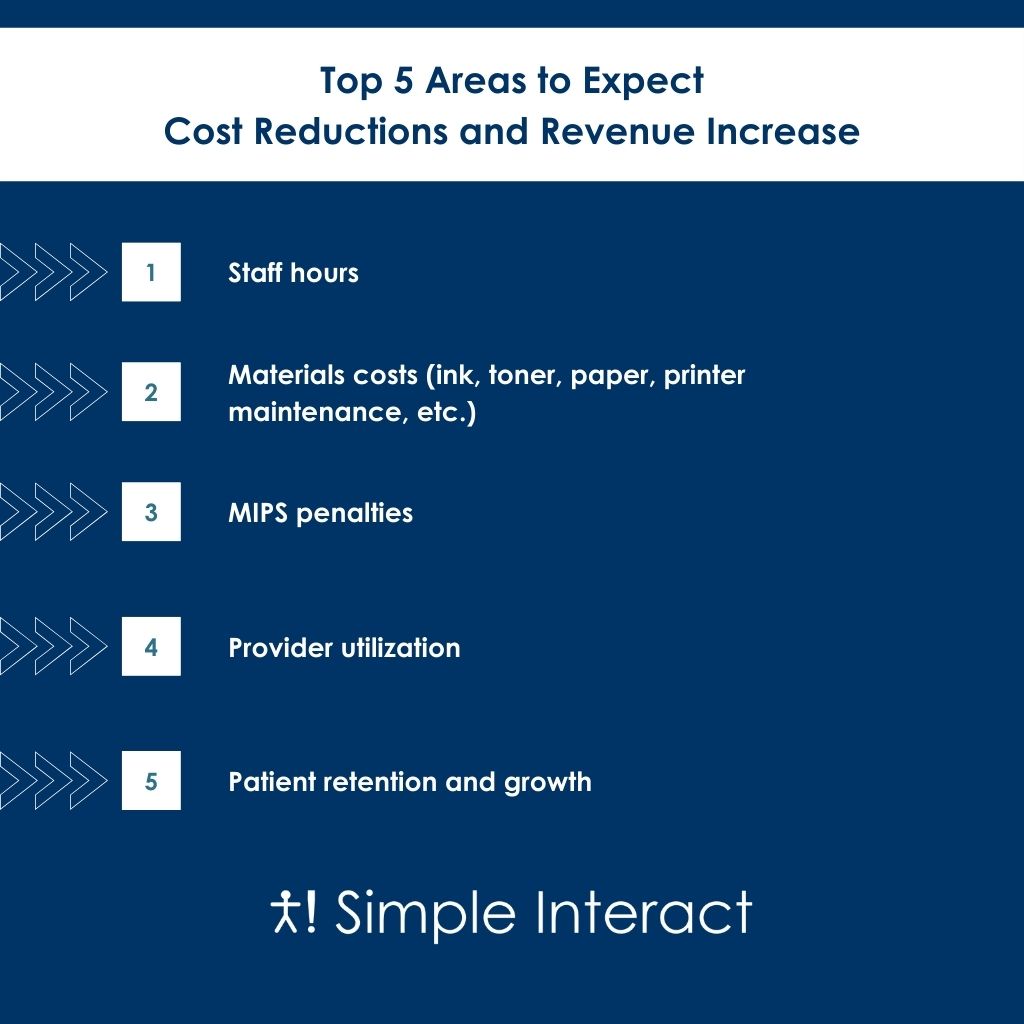How Much Should You Spend on Front Office Automation Tools?

Many expenses come with running a successful medical practice. Each time you consider making an upgrade, hiring additional staff, or investing in new technology, you probably — wisely — ask yourself whether you really need to take on that expense.
Today, front office automation is one of those potential upgrades that may make you pause and consider. Can you really afford this? Is the expense worth it? When will you see a return on your investment?
These are excellent, strategic questions, and in this post we’ll look at some concrete numbers that show how front office automation can make a tangible financial difference in your medical facility. It isn’t some enormous capital expense with a vague promise of future returns. It’s a thoughtful investment that will greatly enhance your net revenue, helping you reach more patients and provide more services — all while requiring fewer office resources and staff hours.
The truth is, you do have to spend some money to make money, and front office automation is no exception. But by reducing waste and improving efficiencies, Simple Interact software pays for itself 5–10x over, providing an excellent return from the start.
The top five areas where you can expect to see reductions in costs and/or increases in revenue include:
- Staff hours
- Materials costs (ink, toner, paper, printer maintenance, etc.)
- MIPS penalties
- Provider utilization
- Patient retention and growth
Front Office Automation in Action
So that we’re not just talking theory, let’s walk through each of these categories in the context of an example.
Imagine an orthopedic practice with 20 providers, 15 mid-levels, and 10,000 visits per month, 2,000 of which are new patients. Also, say their average per-visit revenue is $100, they spend $18 per hour on staff, and their no-show rate is 8%.
With these parameters, we can look at exactly how front office automation would make a significant difference in practice revenue.
Implement Digital Patient Engagement
The consistency and efficiency of automated reminders that let patients confirm, cancel, or request rescheduling reduces the number of no-shows. By our research and calculations, the hypothetical orthopedic practice would see a drop in no-shows from 8% to 6%, a 25% reduction that will save them $240,000 per year in lost revenue.
Using a streamlined task management system, staff is empowered to rebook canceled appointments and reschedule requests. By recapturing 1.5% in leaked appointments and putting them back on the calendar, the practice will save $180,000 in additional revenue per year.
Eliminating repetitive manual tasks reduces future staffing needs. Automating the sending of pre-procedure instructions, making use of broadcast messaging when needed, and reducing manual appointment confirmations would help the practice reduce the need to hire two full-time employees (FTEs) in the future, which translates to more than $100,000 per year in savings.
Digitize Forms
By digitizing patient intake, check-in, ad-hoc consents, and other forms, the practice would reduce costs related to paper, toner, ink, printers, and scanners. This in in itself will save the practice $50,000 per year.
What’s more, having these forms integrated with the practice’s EMR (electronic medical record) system would mean automatic uploading of captured data, images, and PDFs to the patient record. This would dramatically reduce repetitive manual tasks such as data entry, scanning, and shredding for medical support staff.
By getting most patients to participate in the paperless processes, the orthopedic practice would reduce the need to hire 5 FTEs in the future, translating to more than $250,000 per year in savings.
Avoid MIPS Penalties
Front office automation can help improve a practice’s MIPS score and avoid costly MIPS penalties. By incorporating specific data capture measures into patient intake and other digital forms, the orthopedic practice can gather and report the necessary information to get the MIPS score they need. By avoiding the 9% MIPS penalty, they save $24,000 per provider per year. For a practice with 20 providers, that translates to $480,000 per year!
(You can find specific tips for implementing such measures in our post on improving your MIPS score.)
Increase Provider Utilization
All the reduction in manual tasks and increases in efficiencies that come with front office automation greatly speed up patient workflow, which increases provider utilization. At the orthopedic practice, even a 0.5% increase in provider utilization translates to $60,000 per year.
Improve Patient Retention and Growth
Front office automation tools don’t just improve the provider’s numbers; they improve the patient’s experience, too. Quicker office visits, more self-serve options, and clearer and more efficient communication mean happier, more satisfied patients who are less likely to leave for another medical practice.
They’ll also be more likely to refer a practice to friends and family, and there’s a better chance that they’ll write favorable online reviews, which will boost the practice’s online reputation.
If by improving patient satisfaction and experience, the orthopedic practice is able to retain six more patients per provider per year, and gain 12 new patients per provider per year, that would translate to $360,000 more in yearly revenue.
Altogether, our example orthopedic practice gains well over one and a half million dollars in revenue for the year!

What Does Simple Interact’s Font Office Automation Cost?
Front office automation clearly helps to reduce waste and save money while also increasing revenue and facilitating practice growth.
At Simple Interact, we offer a wide range of customizable services that can be incorporated into your front office automation. However, practices don’t typically need to take advantage of every single feature at once. You can customize your experience, so you’re only paying for what you need at a given time.
The average cost of Simple Interact’s front office automation is around $250 per provider per month, depending on the services you choose — a drop in the bucket compared to the potential savings and increased revenue.

Ravi Kalidindi is the Founder and CEO of Simple Interact, a leading Front Office Automation company that helps healthcare facilities across the United States run more efficiently and profitably by boosting staff productivity, reducing provider burnout, and elevating the patient experience. Customers view Ravi as a trusted partner who can quickly comprehend business problems and suggest “keep it simple” solutions that are effective and easier to maintain over time.
Recent Posts
- The Benefits of Using 2-Way SMS Chat for Healthcare Communication
- 2-Way SMS vs. Live Chat: Which Is Best for Bi-Directional Patient Communication?
- Simple Interact Earns A+ Satisfaction Ratings in KLAS Report
- Boosting Healthcare Staff Productivity With a Shared Inbox Dashboard
- Healthcare SMS: What Metrics to Track in Your 2-Way SMS
Categories
Archives
- February 2025
- June 2024
- May 2024
- April 2024
- March 2024
- February 2024
- January 2024
- December 2023
- November 2023
- October 2023
- September 2023
- August 2023
- July 2023
- June 2023
- May 2023
- April 2023
- March 2023
- February 2023
- January 2023
- December 2022
- November 2022
- October 2022
- September 2022
- August 2022
- July 2021
- December 2020
- May 2020
- March 2020
- June 2016